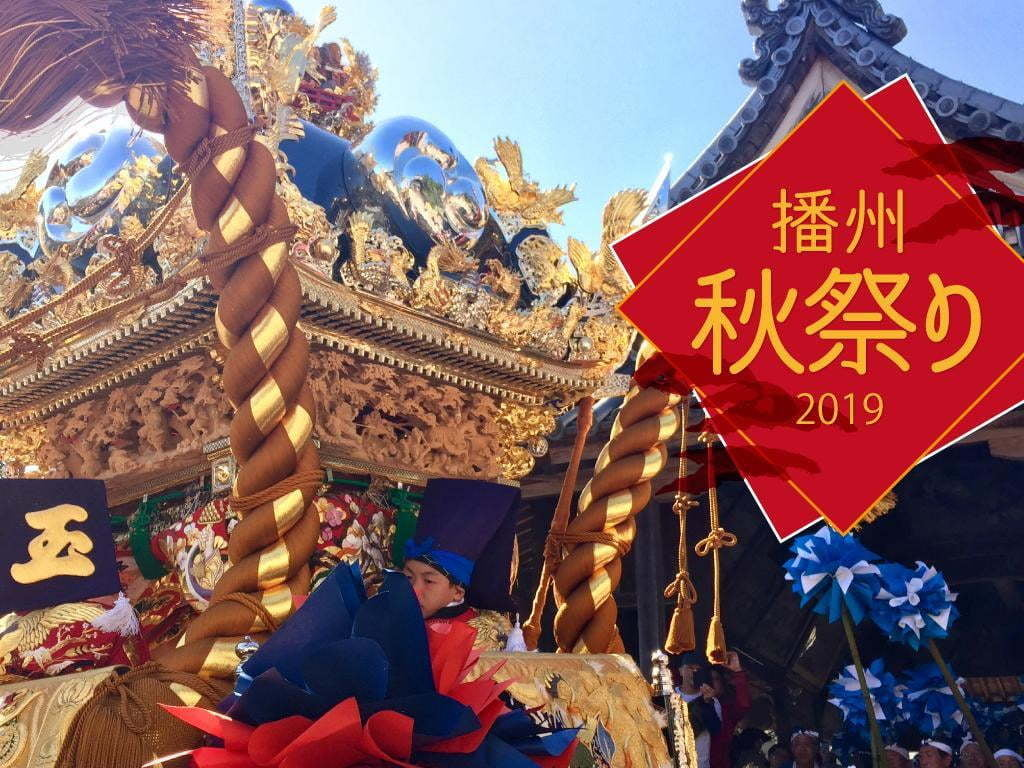Almost every week in October, there are festivals in the areas in and around Himeji, also known as the Harima region. The autumn festivals in this area are famous for their gorgeously decorated and impressively large yatai (portable shrines) and for the enthusiasm and energy of the people. The customs, and shouts involved in the festivals in each area are different and are a point of pride for the people in the region.
Many of the festivals in the Harima region are known as “fighting festivals” (kenka matsuri), where participants slam portable shrines (called mikoshi) that weigh up to two tons into one another. It is said that the harder the shrines crash, the more the kami are pleased. Participants wear fundoshi (called mawashi in the Harima area) and headbands with specific colors denoting either age or the village they belong to.
Harima (播磨) is the name for the southwest portion of Hyogo Prefecture. In the past it was known as Harima no Kuni and was also called Banshu.
Nada Fighting Festival
The largest festival is the Nada Fighting Festival in Himeji, attracting over 100,000 visitors a year. It takes place at Matsubara Hachiman Shrine, a shrine southeast of Himeji Station near Shirahamanomiya Station. It can be accessed by the Sanyou/Hanshin Railway, taking 15 minutes from Himeji, 50 minutes from Kobe, and 80 minutes from Osaka.
The festival is split into two days, with the 1st day (October 14th) being the Yoi-Miya (宵宮), a day of preparation where the seven yatai of the surrounding towns receive blessings. On this day, the yatai are lined up and perform Neri-dashi (練りだし) where they are paraded around. They then perform Neri-Awase (練り合わせ) where they are banged against each other, though this is not as violent as the main event and the goal is not destruction.
October 15th is the main event. The event starts with a parade of the 7 yatai. After this, 3 mikoshi (portable shrines meant to be crashed into each other and destroyed) enter. The heaviest is carried by men over 36, the 2nd is carried by men aged 26-35, and the 3rd one is carried by men aged 18-25. This event is where the Nada Fighting Festival gets its reputation as being extremely brutal and violent.
Nada Fighting Festival 2018
Nada Fighting Festival 2018
One thing of note is that foreigners/tourists cannot reserve seats. They are all reserved by locals and families of the participants. If you’re lucky, you may be invited by some locals to sit with them! This event is extremely popular and it is recommended to get there early if you want to get a good view.
Main Festivals:
- Hama-no-miya Tenmangu (Himeji City) : 10/8 (Tues)- 10/9 (Wed)
- Ebisu-no-miya Tenman-jinja (Himeji City) : 10/8 (Tues) – 10/9 (Wed)
- Sone Tenmangu (Takasago City) : 10/13 (Sun) – 10/14 (Mon)
- Oshio Tenmangu (Himeji City) : 10/14 (Mon) – 10/15 (Tues)
- Nada Fighting Festival (Himeji City) : 10/14 (Mon) – 10/15 (Tues)
- Aga Shrine (Himeji City) : 10/17 (Thurs) – 10/18 (Fri)
- Arakawa Shrine (Himeji City) : 10/19 (Sat) – 10/20 (Sun)
- Tobishima Shrine (Tatsuno City) : 10/19 (Sat) – 10/20 (Sun)
- Usuki Hachiman Shrine (Himeji City) : 10/21 (Mon) – 10/22 (Tues)
The second week of October kicks off the matsuri season with the festivals in Shikama, Himeji. There are two festivals, Hamanomiya Tenmangu and Ebisunomiya Tenman-jinja on October 8/9th. Hamanomiya Tenmangu specifically is famous for its Daiba-sashi, where they lift the 2 ton shrines high over their heads.

http://www.city.himeji.lg.jp/var/rev0/0001/5266/h151.jpgg
The next week has many more festivals, starting with the festival of Sone Tenmangu in Takasago on October 13/14th. This area is famous for their futon yatai (they put several futon on top as part of the decoration).

https://www.himeji-mitai.com/feature/261371.html
Next up is the Oshio Tenmangu festival on October 14/15th. This festival takes place at the same time as the Nada Fighting Festival. The area has 6 yatai, but is most well known for their lion dance.
In the same week, Himeji’s Aga Shrine’s festival takes place on October 17/18th. It is known for its large amount of yatai. In total there are 18 yatai which all compete against one another.
After Aga Shrine is the Arakawa Shrine festival on October 19/20th, also found in Himeji. This festival is also known as the koimo matsuri (taro bud festival) because the festival’s yatai look like taro buds being washed in a mortar when viewed from the main hall. The festival is also known for its “stair climbing”, where each yatai must be carried up a steep staircase to enter the shrine.
Tobishima Shrine festival is at the same time as Arakawa Shrine’s, and is one of the largest autumn festivals in Tatsuno City.
Finally is Usuki Hachiman Shrine’s festival on October 21/22nd, near Aboshi Station west of Himeji. This festival is also known as the Lantern Festival. In addition to the many yatai, the festival is known for its intricate lantern displays which are crashed together and destroyed.

https://usukihachiman.or.jp/cyochin_matsuri/cyochin_neri/
In addition to these main festivals, there are many other festivals in the Harima area:
- Takasago Shrine (Takasago City) : 10/10 (Thurs) – 10/11 (Fri)
- Iwatsubo Shrine (Miki City) : 10/19 (Sat) – 10/20 (Sun)
- Omiya Hachimangu (Miki City) : 10/12 (Sat) – 10/13 (Sun)
- Yonedaten Shrine (Takasago City) ; 10/12 (Sat) – 10/13 (Sun)
- Arai Shrine (Takasago City) : 10/12 (Sat) – 10/13 (Sun)
- Wakamiya Shrine (Miki City) : 10/6 (Sun)
- Shioya Kou Shrine (Ako City) : 10/20 (Sun)
- Ako Hachimangu (Ako City) : 10/20 (Sun)
- Komatsubara Sanshadai Shrine (Takasago City) : 10/12 (Sat) – 10/13 (Sun)
- Oshiko Shrine (Takasago City) : 10/19 (Sat) – 10/20 (Sun)
- Iwa Shrine (Shiso City) : 10/15 (Tues) – 10/16 (Wed)
- Hiyoshi Shrine (Kasai City) : 10/13 (Sun)





